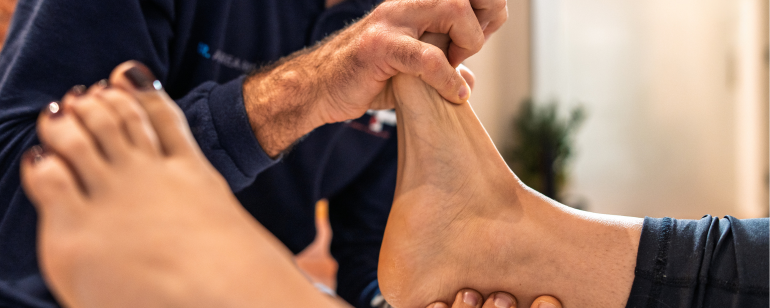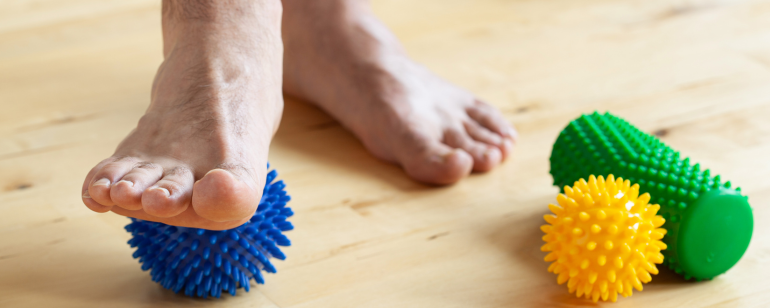Pain under the foot is one of the most common complaints in the musculoskeletal system. It can occur suddenly or develop gradually. People of all ages are affected. People with standing occupations, people who are active in sports or people with unfavorable footwear complain particularly frequently about discomfort in the sole of the foot. The symptoms have a considerable impact on everyday life and often lead to postural rest, which in turn can result in further muscular imbalances.
Common causes
In many cases, the complaints are caused by plantar fasciitis. This is an irritation or inflammation of the tendon plate on the underside of the foot. The plantar fascia stretches from the heel bone to the toes and serves to stabilize the arch of the foot. Micro-injuries and inflammation can occur if it is overloaded – for example due to prolonged standing, intensive training, unsuitable footwear or foot misalignment. A sharp pain in the heel area is typical, especially after periods of rest such as getting up in the morning.
Another common trigger is the heel spur, a bony protrusion at the base of the plantar fascia on the heel bone. The spur itself does not usually cause any pain. The pain is caused by inflammation of the surrounding soft tissue. Flat feet, splay feet and other static changes often lead to overloading of the sole of the foot and are therefore a risk factor.
Shortened calf muscles, reduced strength in the arch of the foot, obesity or neuromuscular disorders can also exacerbate the pain symptoms. Long-term incorrect loading in everyday life is particularly critical, as it permanently disrupts the foot’s natural shock absorber function.

Physiotherapeutic treatment
The physiotherapeutic examination begins with a detailed medical history and a close look at the gait pattern, leg axis and foot statics. Local palpation of the painful areas provides information on tissue tension, possible trigger points and inflammatory changes.
Different therapeutic approaches are used depending on the findings:
- Manual techniques to loosen the plantar fascia, calf muscles and surrounding connective tissue
- Fascia techniques to reduce tension along the back muscle chain
- Strengthening exercises for the arch of the foot and the short foot muscles
- Stretching the calf muscles to relieve the tendon insertions
- Gait analysis and training to correct functional movement patterns
- Tape bandages to relieve the affected structures in everyday life
- Advice on suitable footwear or the use of insoles
The combination of passive treatment and active exercise therapy is particularly important. The aim is to improve the load conditions in the foot in the long term and prevent recurrence of symptoms.
Exercises for at home
A simple but effective self-treatment method is to roll out the sole of the foot in the morning with a hedgehog ball or a fascia roller. This promotes blood circulation and reduces tension in the plantar fascia.
Regular stretching of the calf muscles is also recommended. To do this, stand with your forefoot on a step, slowly lower your heels and hold the stretch for around 30 seconds. Three repetitions a day are recommended.
Grasping small objects with the toes or consciously straightening the arch of the foot while standing also strengthens the intrinsic muscles of the foot.

When further clarification is necessary
If the pain persists for longer than two to three weeks or worsens despite consistent self-treatment and physiotherapy, a medical diagnosis is required. In rare cases, systemic diseases, nerve compression or rheumatic processes may be behind the symptoms.
Conclusion
Pain under the foot is usually caused by overloading, muscular imbalances or static changes. Structured physiotherapeutic treatment can usually significantly alleviate the symptoms. It is crucial that not only the symptoms but also the causes are treated in a targeted manner – so that the foot can bear weight again and everyday life remains pain-free.
